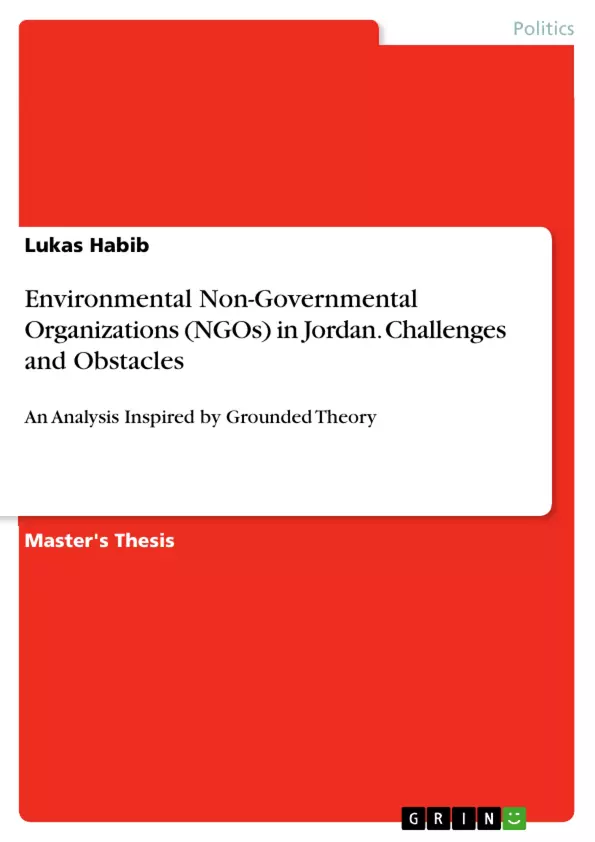The Hashemite Kingdom of Jordan is characterized by a high vulnerability regarding climate change-induced effects and environmental developments. As governmental bodies seem to fail the task of preserving the human habitat, environmental NGOs are already filling a gap. Likewise, the cooperation with international organizations is also an important factor for the work of national NGOs. This raises the question, if and how the government of Jordan and international organization create obstacles for environmental NGOs. After conducting an analysis inspired by grounded theory, including a two step coding process of primary data, it becomes obvious that environmental NGOs in Jordan are facing several challenges. Firstly, they are adopting governmental tasks. Secondly, NGOs are challenged by a high level of competition. Thirdly, they are confronted with difficulties created by international organizations and the government. Furthermore, those actors are in need of gaining financial security and to improve international cooperation within the Levant to diminish climate change-induced effects, negative environmental developments, and to contribute to a sustainable environment.
Inhaltsverzeichnis (Table of Contents)
- A Climate Change-Induced Risks for Ecological and Human Systems - An Overview
- B Environmental NGOs in Jordan: Challenges and Obstacles. An Analysis Inspired by Grounded Theory
- B. I Relevance
- B. I.1 Environmental Situation in the Middle East
- B. I.1.a) Water Scarcity
- B. I.1.b) Land Degradation
- B. I.1.c) Marine and Coastal Degradation
- B. I.1.d) Air Pollution
- B. 1.2 General Challenges for the Levant
- B. 1.3 Filling a Research Gap
- B. I.1 Environmental Situation in the Middle East
- B. II Selecting the Case - From Macro to Micro
- B. II.1 Selecting Environmental NGOs in Jordan
- B. II.2 Macro Level
- B. II.3 Meso Level
- B. II.4 Micro Level
- B. II.5 Purpose and Possible Critique of the Case Selection
- B. III Creating the Basis for a Grounded Theory
- B. III.1 Introducing and Integrating Grounded Theory
- B. III.2 Framework for Generating a Grounded Theory
- B. III.3 Describing the Interview Questionnaire
- B. III.4 Initial Coding
- B. III.5 Sampling and Advancement of Initial Codes
- B. III.6 Focused Coding
- B. III.7 Sampling and Advancement of Focused Codes
- B. IV Correlating the Results with the Hypotheses
- B. V Generating the Theory for this Analysis
- B. VI Limitations of the Analysis and Theory
- B. I Relevance
- C Recommendations for Future Research
Zielsetzung und Themenschwerpunkte (Objectives and Key Themes)
This master's thesis aims to analyze the challenges and obstacles faced by environmental NGOs in Jordan, particularly in the context of climate change and its induced effects. The study is grounded in qualitative research methods, specifically grounded theory, to provide a comprehensive understanding of the complex dynamics at play.
- The environmental situation in the Middle East and its specific challenges for Jordan.
- The role of environmental NGOs in addressing environmental issues and filling gaps left by governmental bodies.
- The challenges faced by NGOs in Jordan, including competition, financial insecurity, and obstacles created by governmental and international organizations.
- The importance of international cooperation and collaboration to mitigate climate change-induced effects and promote sustainable environmental practices.
- The need for improved financial security and collaboration among NGOs and relevant stakeholders in the Levant region.
Zusammenfassung der Kapitel (Chapter Summaries)
- Chapter B.I: Relevance: This chapter establishes the context for the study by exploring the environmental situation in the Middle East, with a particular focus on Jordan. It examines the challenges posed by water scarcity, land degradation, marine and coastal degradation, and air pollution. It also discusses the general challenges faced by the Levant region and highlights the research gap that this study aims to address.
- Chapter B.II: Selecting the Case - From Macro to Micro: This chapter delves into the process of selecting the case study for the research, focusing on environmental NGOs in Jordan. It outlines the macro, meso, and micro levels of analysis used in the study, explaining the rationale behind the case selection and addressing potential critiques.
- Chapter B.III: Creating the Basis for a Grounded Theory: This chapter introduces the concept of grounded theory and its application in this research. It describes the framework used for generating a grounded theory, outlines the interview questionnaire, and details the initial and focused coding processes. It also discusses the sampling and advancement of codes throughout the analysis.
- Chapter B.IV: Correlating the Results with the Hypotheses: This chapter examines the findings of the analysis and correlates them with the initial hypotheses. It provides insights into the key themes and patterns that emerged from the data.
- Chapter B.V: Generating the Theory for this Analysis: This chapter presents the grounded theory that emerged from the analysis, offering a comprehensive explanation of the challenges and obstacles faced by environmental NGOs in Jordan. It highlights the key factors that contribute to these challenges and the implications for future research and practice.
Schlüsselwörter (Keywords)
This study focuses on the challenges and obstacles faced by environmental NGOs in Jordan, using grounded theory as a framework for analysis. The research examines the impact of climate change on the country's environment and explores the role of NGOs in addressing these issues. Key themes and concepts include: Jordan, Grounded Theory, Climate Change, NGOs, Qualitative Research, Environmental Sustainability, International Cooperation, and Sustainable Development.
- Quote paper
- Lukas Habib (Author), 2015, Environmental Non-Governmental Organizations (NGOs) in Jordan. Challenges and Obstacles, Munich, GRIN Verlag, https://www.grin.com/document/303592



